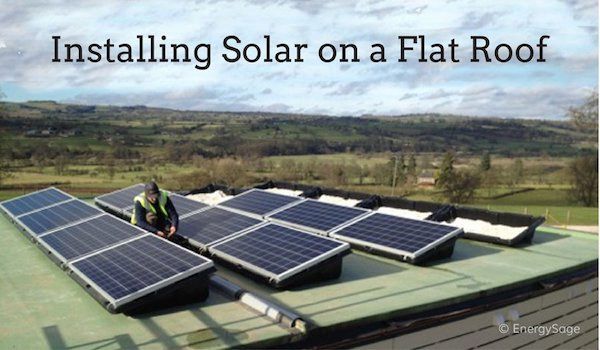Flat roof solar installations are becoming increasingly popular as businesses and homeowners look to maximize their rooftop space for sustainable energy solutions. While installing solar panels on a flat roof offers unique advantages, it also comes with specific challenges that require careful planning and execution. Whether you are a seasoned solar professional or considering your first installation, these expert tips will guide you to a successful flat roof solar install.
1. Assess Roof Condition and Load Capacity
Before proceeding with any flat roof solar install, it’s crucial to evaluate the condition of the roof. A professional inspection can determine whether the roof can support the added weight of the solar panels, racking system, and ballast. Key factors to consider include:
- Structural Integrity: Ensure the roof is free from damage, leaks, or weak spots.
- Load-Bearing Capacity: Flat roofs must support the weight of solar equipment and withstand additional loads, such as snow or wind pressure.
- Longevity: If the roof requires repairs or replacement in the near future, address these issues before installation.
2. Optimize Solar Panel Placement for Maximum Efficiency
Flat roofs provide flexibility in solar panel placement, allowing for creative configurations. However, optimization is essential to achieve maximum energy output. Consider the following:
- Tilt Angles: Unlike sloped roofs, flat roofs require racks or mounting systems to angle the panels for better sunlight capture. A tilt of 5 to 15 degrees is typically recommended.
- Orientation: Panels should face true south in the Northern Hemisphere and true north in the Southern Hemisphere for optimal exposure.
- Shading Analysis: Conduct a thorough shading analysis to identify potential obstructions, such as nearby buildings, trees, or HVAC units.
3. Choose the Right Mounting System
The choice of mounting system plays a pivotal role in the success of a flat roof solar install. Popular options include:
- Ballasted Mounts: These systems rely on weights to secure the panels, minimizing the need for roof penetration.
- Penetrative Mounts: These involve anchoring the system directly to the roof structure, offering enhanced stability in high-wind areas.
- Hybrid Systems: A combination of ballasted and penetrative mounts for projects requiring additional support.
Evaluate the roof’s material and weather conditions to select the most suitable mounting system.
4. Prioritize Waterproofing and Roof Protection
Flat roofs are more prone to water pooling, making waterproofing critical during installation. To prevent leaks and structural damage:
- Use high-quality roofing materials and sealants.
- Opt for non-penetrative systems if possible to avoid puncturing the roof membrane.
- Work with contractors experienced in flat roof solar installs to ensure minimal impact on the roof’s integrity.
5. Conduct a Wind Load Analysis
Flat roofs are exposed to varying wind loads, which can pose a risk to solar panel stability. A wind load analysis ensures the system is securely installed and complies with local building codes. Key considerations include:
- Ballast Weight Distribution: Ensure the ballast system is evenly distributed to resist wind uplift.
- Aerodynamic Designs: Use mounting systems designed to reduce wind drag and pressure on the panels.
6. Factor in Maintenance and Accessibility
Flat roof solar installations should be designed with future maintenance in mind. Ensure adequate space is left between rows of panels for technicians to perform inspections, cleaning, and repairs. Regular maintenance ensures optimal performance and extends the lifespan of the system.
7. Account for Temperature and Ventilation
Flat roofs can trap heat, which may affect solar panel performance and lifespan. To mitigate these effects:
- Choose high-quality panels with low temperature coefficients.
- Use raised mounts to allow airflow beneath the panels, reducing heat buildup.
- Install reflective roof coatings to lower ambient temperatures.
8. Ensure Compliance with Local Regulations
Flat roof solar installs must meet local building codes and regulations. Collaborate with experienced installers who are familiar with regional requirements, including:
- Zoning laws.
- Fire safety codes.
- Electrical standards.
Securing necessary permits and inspections ensures a smooth installation process.
9. Monitor Energy Performance with Advanced Tools
Incorporating monitoring systems into your flat roof solar install allows you to track energy production and system performance in real-time. Modern tools provide insights into efficiency, alert you to potential issues, and help optimize energy output.
10. Partner with Experienced Installers
A flat roof solar install is a complex process requiring expertise in solar technology, roofing systems, and structural engineering. Hiring certified professionals ensures the project is completed safely, efficiently, and to the highest standards. Look for installers with:
- Proven experience in flat roof installations.
- Positive customer reviews and references.
- Comprehensive warranties for workmanship and materials.
Benefits of a Flat Roof Solar Install
Investing in a flat roof solar install offers numerous advantages, including:
- Maximized Space Utilization: Flat roofs provide a large, unobstructed surface ideal for solar arrays.
- Cost Savings: Solar energy reduces electricity bills and provides long-term savings.
- Environmental Impact: Solar power significantly reduces carbon emissions and supports sustainability goals.
- Flexible System Expansion: Flat roofs allow for easy scaling of the system as energy needs grow.
Conclusion
A flat roof solar install can be a game-changer for your energy needs, offering environmental and financial benefits. By following these expert tips—evaluating your roof’s condition, optimizing panel placement, choosing the right mounting system, and partnering with skilled professionals—you can ensure a successful installation that delivers maximum efficiency and long-term value.
With careful planning and execution, your flat roof solar installation will stand as a beacon of sustainability, helping you harness the power of the sun while reducing your carbon footprint.



